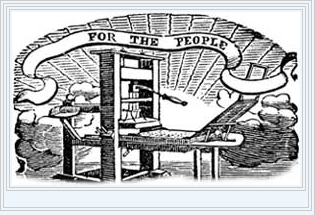
The Role of a Free Media
American Corner | 2013-01-24 17:47

"When men have realized that time has upset many fighting faiths, they may come to believe . . . that the ultimate good desired is better reached by free trade in ideas -- that the best test of truth is the power of the thought to get itself accepted in the competition of the market. . . . That at any rate is the theory of our Constitution. It is an experiment, as all life is an experiment."
-- U.S. Supreme Court Justice
Oliver Wendell Holmes
in 1919
For a society to be considered truly democratic, there should be a high degree of protection accorded to the expression of ideas in published form, whether the medium is newspapers, magazines, books, pamphlets, motion pictures, television or, most recently, the Internet. The American experience over a period of two centuries offers an illuminating example of one nation's attempt to set ground rules for expression. Of course, these experiences are unique to the culture and history of the United States, but the general principles they elucidate have wide applications in other democratic societies.
The U.S. Constitution, the essential bedrock of the American governmental system, would not have been ratified by the original 13 states in 1791 without a set of 10 amendments, called the Bill of Rights, to protect individual freedoms. It was no accident that the right of free expression by the media was enshrined in the very first of these amendments. The First Amendment reads in part: "Congress shall make no law . . . abridging the freedom of speech, or of the press." To the Founders, the men who drafted the Constitution and the Bill of Rights, the printed page -- generally in newspapers and pamphlets -- was the published media. Hence the term "press" in the First Amendment. Throughout American history, the freedoms of speech and press, linked as they are in the First Amendment, have likewise been intertwined -- both in the mind of the public and in the minds of judges called upon to decide cases dealing with published expression.
Perhaps the best way to appreciate the complex and evolving role of a free media in the United States is to examine the historical development of this concept through decisions by American courts. While the First Amendment guarantees a considerable measure of press freedom, it is the U.S. judicial system that has defined exactly what this concept means in practice. And it is the courts generally that have taken the idea beyond its 18th-century roots in English common law and protected this right against the forces in American society made uncomfortable by too much freedom of the press.
The Zenger trial and seditious libel
A 1734 trial of New York newspaper publisher John Peter Zenger offers an example of the general proposition that freedom of the press was not understood in the English colonies on the North American continent in the same way it is today. The colonial government of New York charged Zenger with seditious libel for printing an article brutally criticizing the colony's royal governor. Black's Law Dictionary defines libel as written communication that "tend[s] to expose one to public hatred, shame . . . contempt, ridicule, . . . or disgrace. . . ." Among other things, Zenger's paper had claimed that the governor erected courts without the consent of the legislature and arbitrarily denied members of the colony the right of trial by jury. Zenger, through his attorney, did not deny that he printed these charges. He simply asserted that he had the right to publish criticism of a public official, even criticism that held that official up to ridicule, as long as the criticism was truthful. In a landmark decision, the jury acquitted Zenger, and helped establish the principle that truth is a defense against charges of libel. But the jury verdict in the case did not change the English legal principle, powerfully enunciated by the distinguished legal writer William Blackstone in the late 18th century, that publishing "what is . . . mischievous" was a crime that could be punished.
In 1798, prompted by fear that the radicalism of the French Revolution might find its way across the Atlantic Ocean, the majority in the U.S. Congress passed the Sedition Act, making it a crime to "write, print, utter or publish . . . any false, scandalous and malicious writing" against the government. A number of individuals and newspapers were successfully prosecuted under this law. One was the publisher James Thomson Callender, who was charged with criminal libel for referring to President John Adams in 1800 as a "hoary-headed incendiary . . . whose hands are reeking with blood." Callender, an unpopular figure considered scurrilous even in those days of sometimes robust political invective, was convicted and sent to prison for several years. He was pardoned by Thomas Jefferson, shortly after the Virginian ascended to the presidency in 1801.
Share this page



















